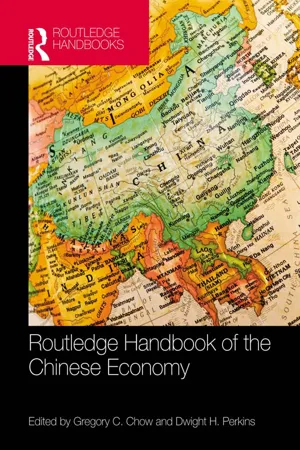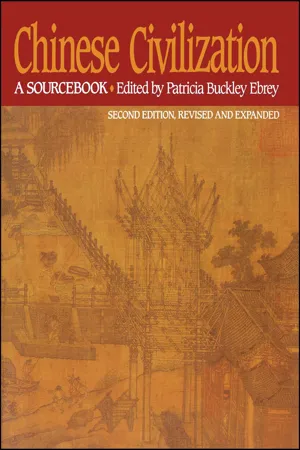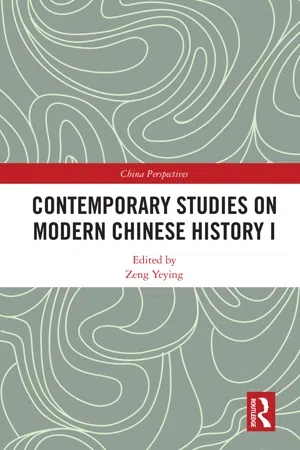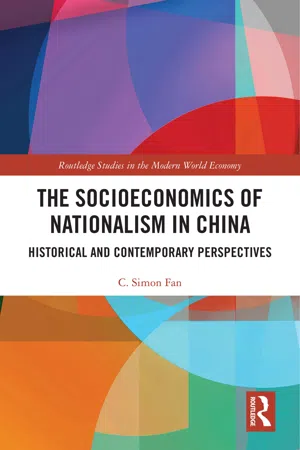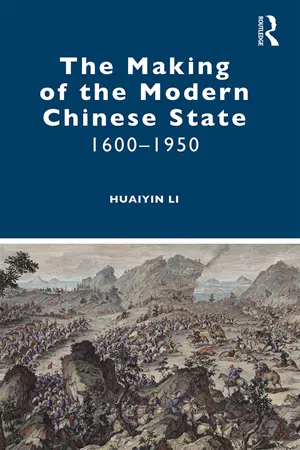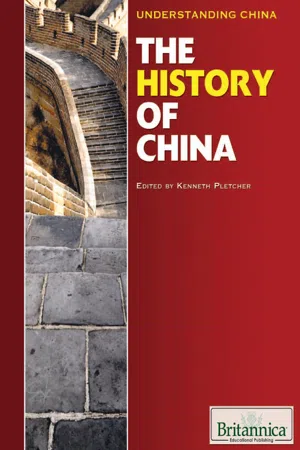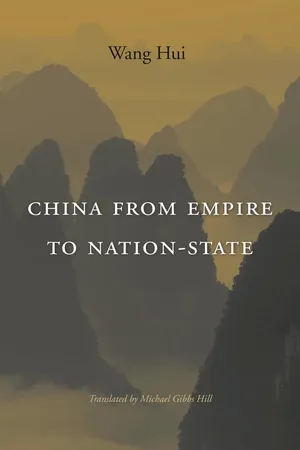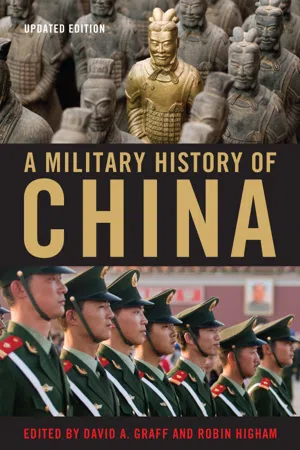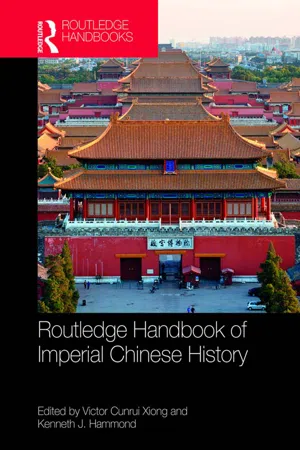History
Qing Dynasty
The Qing Dynasty was the last imperial dynasty of China, ruling from 1644 to 1912. It was established by the Manchus and was known for its expansion and consolidation of territories, as well as its embrace of Confucianism. The dynasty experienced both periods of prosperity and decline, and its eventual downfall led to the establishment of the Republic of China.
Written by Perlego with AI-assistance
Related key terms
10 Key excerpts on "Qing Dynasty"
- eBook - ePub
- Gregory C. Chow, Dwight H. Perkins(Authors)
- 2014(Publication Date)
- Routledge(Publisher)
Table 2.1 .2 The Qing Dynasty (1644–1911)
In the Qing Dynasty, China, with a majority of Han nationality, was ruled by an alien nationality, the Manchus. Among all the Qing emperors, the first four, Shunzhi, Kangxi, Yongzheng, and Qianlong were extremely capable rulers. Under their rule, the empire acquired a huge land mass and won most of the battles against the nomads from the north and northwest regions of present day China.The Qing court under Emperor Kangxi stopped the Russians from advancing into western Mongolia and reached a settlement with them in the Treaty of Nerchinsk in 1689. Emperors Kangxi and Qianlong both fought hard-won battles with Dzungar, a powerful empire in the northwestern part of China and eventually eliminated them. In the south, battles were fought with the Burmese, the Yao and Miao ethnic groups in the southwest, the Nepalese, and the Qing army made incursions into Tibet, Vietnam, and Taiwan. The victories won the Qing Dynasty an extended period of peace – although this was both good and bad for the country. It allowed the country to prosper under a firmly centralized institution. However, the peace, stability, and autonomy enjoyed at the county level had allowed the interest groups to grow unabated. It also made the Qing government complacent and the economy stagnated, facing few external challenges until the late Qing period when the country woke up to European and Japanese aggression. Ironically, the extended period of peace laid the seed for the empire’s own destruction.The Qing government, similar to the Ming government before, was highly centralized and inward-looking. Without outside threats from early to mid-Qing, the emperor looked inwards and increased his domination at home.9 The Qing court strengthened its rule by sidelining the Censorate, a traditional agency in Chinese imperial polity that spoke out against abuses of imperial power. The office of the Prime Minster was dispensed (as in the Ming Dynasty), the collection of tax revenue was centralized (Myers and Wang 2002: 604). Literary inquisition was imposed to intimidate the Han intellectuals from speaking their minds. Qianlong even installed a community-based system of law enforcement and civil control known as the Baojia system of punishment to control his subjects.10 - eBook - ePub
Chinese Civilization
A Sourcebook, 2nd Ed
- Patricia Buckley Ebrey, Patricia Buckley Ebrey(Authors)
- 2009(Publication Date)
- Free Press(Publisher)
PART VI
THE Qing DynastyAlthough the Ming was overthrown by peasant rebellions of the usual sort, the next dynasty was founded not by a warlord or rebel leader but by the chieftains of the Manchus, a non-Chinese people living in the hilly forests and plains to the northeast of China proper, the large area generally called Manchuria. The Manchus had long been in contact with the Mongols and Chinese and for decades had been building up the political and military institutions needed to govern sedentary farming populations.Like the Mongols, the Manchus were alien conquerors; yet their dynasty, the Qing (1644-1911), did not represent nearly as fundamental a break with Chinese traditions. The Manchus tried to maintain their own identity and traditions, but largely left Chinese customs and institutions alone. In fact, in many respects the eighteenth century was the apogee of Chinese civilization. Some two to three hundred million people lived peaceably in an empire even bigger than China today, stretching from Manchuria, through Mongolia, and into Central Asia and Tibet. Traditional scholarship and arts flourished under the patronage of the Qing emperors, and even in rural areas schools were common and basic literacy relatively high.Yet during the Qing Dynasty the stability of traditional Chinese civilization was being gradually undermined by the steady increase in the size of the population. By 1850 the population reached about four hundred million. This demographic growth affected many other aspects of life. By the beginning of the nineteenth century, the pressure of population on available land resources was becoming acute. All of the land which could profitably be exploited using traditional methods was already under cultivation, so any increase in food supply had to come from less and less rewarding additions of labor or marginal land. As a consequence, the prospect of widespread suffering became very real, especially in times of drought or flood. The government structure did not keep pace with the population’s growth; in fact, it remained static in size during the Qing period, so that by the end of the dynasty government services and control were stretched thinner to cover two or three times as large a population as at the beginning. At the local level more authority was taken over by the gentry, especially by men who had passed the lower-level civil service examinations. - eBook - ePub
- Zeng Yeying, Zeng Yeying(Authors)
- 2020(Publication Date)
- Routledge(Publisher)
For this reason, while still an important part of modern Chinese history, the late Qing Dynasty with its inherent attribute as a part of Qing history has been increasingly revealed. Its connection with the pre-Qing and mid-Qing history is also strengthened, and its distinction within the history of the Republic of China has become increasingly prominent. Interestingly, when discussing the periodization of modern history in the past, the scholars involved used to avoid either taking the time when the Qing court was overthrown as the node of history, or mentioning the abdication of the Qing emperor, even though it was used as the node, while only mentioning the failure of the Revolution of 1911 and Yuan Shikai’s coming to power. But now the event has become the natural basis for periodization and self-evident at that. In the early 1990s, the ten volumes of The Complete History of the Qing Dynasty, edited by Wang Rongsheng, were published successively, having officially included the history of the late Qing Dynasty in its system, with the seventh and ninth volumes specially devoted to the political history of the late Qing Dynasty. Fan Wenlan and Cai Meibiao continued writing the ten volumes of General History of China, which originally ended with Jiaqing’s reign, and was now extended to cover late Qing Dynasty history. In the Chinese history part of the Great Encyclopedia of China, the first comprehensive encyclopedia of its kind, there is not even an entry for “modern Chinese history,” with the corresponding parts included in the “Qing history” and the “history of the Republic of China.” But modern Chinese history still has its basis, of which the political history of the late Qing Dynasty is still an important part. The reason is very simple: people need to know their yesterday and the day before yesterday, and the late Qing Dynasty is not far from us after all - eBook - ePub
The Socioeconomics of Nationalism in China
Historical and Contemporary Perspectives
- C. Simon Fan(Author)
- 2022(Publication Date)
- Routledge(Publisher)
1662–1722), his son, Emperor Yongzheng (r. 1723–1735), and his grandson, Emperor Qianlong (r. 1735–1796) marked the zenith of the prosperity of the Qing Dynasty, and of the whole Chinese history of feudal societies. For example, at the end of Shunzhi period, the Chinese population was about 40–50 million; by the end of Qianlong period, the population had increased to 313 million. In other words, over a 113-year period, the Chinese population increased six- to seven-fold. Finally, despite the unprecedented prosperity of the middle period of the Qing Dynasty, the Manchu rulers maintained a relatively simple lifestyle and were rather constrained in exploiting Chinese peasants for their own benefit. For example, it is estimated that the annual expenditure on the harem of Emperor Yongzheng of the Qing Dynasty was less than the daily expenditure on the harem of Emperor Wanli of the Ming dynasty (Ma, 2012). Although the initial ruling class of the Qing Dynasty was an ethnic minority group of China, the Jurchens or Manchus, it is often rated as the best dynasty in Chinese history in terms of people’s welfare. It was the last imperial dynasty of China, coming to an end only when China became a republic in 1912. 6.4 A Further Discussion Based on Economic Theories 6.4.1 The Choice of the Type of Nationalism is Endogenous While “Chinese” is regarded a race and nationality today, in ancient times Chinese was more of an identity marker of civilization. In fact, in ancient China, almost everyone could choose to be Chinese as long as he/she followed the social norms based on Confucianism. Today, most of the Chinese in China are called “Han Chinese.” However, Han Chinese originally referred to the Chinese in the Han dynasty of China. Thus, the concept of “Chinese” in ancient times could be seen as an analog of the concept of “American” today - eBook - ePub
- Huaiyin Li(Author)
- 2019(Publication Date)
- Routledge(Publisher)
For long, historians have tended to interpret the conquest dynasties in Chinese history from a Han-centered perspective, assuming a shared sense of superiority among the Han people in their relations with those of different ethnic origins, and underscoring their abilities to assimilate the conquerors that were inferior to the Han economically and culturally. John K. Fairbank described this dominant attitude among the ruling elites of Chinese dynasties as a form of culturalism, to distinguish it from nationalism that is premised on competition and equality among all nation-states in the modern world. It was this assumption of cultural superiority that undergirded the Qing Dynasty’s regulation of foreign trade under the tributary system (Fairbank 1969; Hamashita 2008: 29–32). When explaining the Qing’s striking longevity in relation to other “alien” dynasties in Chinese history and its success in ruling a vast, multiethnic land, a prevailing view up to the 1980s was to emphasize its policies of Sinicization: the Manchus who founded the dynasty and conquered China not only inherited from the preceding Ming the entire administrative system at all levels as well as the Confucian ideology that accompanied the system, but they also embraced Chinese culture and language to such an extent that by the early nineteenth century few Manchus were able to speak their own language. The Qing was able to rule China for more than two and a half centuries, according to this thesis, in large part because of its institutional adaptation (Fairbank and Goldman 2006: 147) or Sinicization (Ho 1967, 1998) that allowed the Confucian elites of the Han people to develop identity and loyalty with the conquest dynasty.More recent studies since the 1990s have challenged this interpretation in two important ways. Instead of viewing the Qing as another Chinese dynasty in China’s long series of “dynastic cycles,” they present a new image of the emperors of the Qing at the peak of its influence in the eighteenth century as cosmopolitan rulers seeking to embody in their rulership the religious authorities and cultural values of different subject peoples on their territory (Rawski 1996). A Qing ruler arguably acted as a sagely, benevolent emperor, a khan, and a cakravartin - eBook - ePub
- Britannica Educational Publishing, Kenneth Pletcher(Authors)
- 2010(Publication Date)
- Britannica Educational Publishing(Publisher)
Dorgon (Chinese temple name: Chengzong; b. Nov. 7, 1612—d. Dec. 31, 1650), prince of the Manchu people, was instrumental in founding the Qing (Manchu) dynasty in China. He joined his former enemy Wu Sangui in driving the Chinese rebel Li Zicheng from Beijing, where Li had already unseated the last Ming-dynasty emperor. Though some wanted to put Dorgon on the throne, he saw to it that his nephew Fulin was proclaimed emperor (Dorgon acted as regent); this loyalty and selflessness won him the high regard of future historians.It took the Manchu several decades to complete their military conquest of China. In 1673 the conquerors confronted a major rebellion led by three generals (among them Wu Sangui), former Ming adherents who had been given control over large parts of southern and southwestern China. That revolt, stimulated by Manchu attempts to cut back on the autonomous power of these generals, was finally suppressed in 1681. In 1683 the Qing finally eliminated the last stronghold of Ming loyalism on Taiwan.THE QING EMPIRE
After 1683 the Qing rulers turned their attention to consolidating control over their frontiers. Taiwan became part of the empire, and military expeditions against perceived threats in north and west Asia created the largest empire China has ever known. From the late 17th to the early 18th century, Qing armies destroyed the Oyrat empire based in Dzungaria and incorporated into the empire the region around the Koko Nor (Qinghai Hu, “Blue Lake”) in Central Asia. In order to check Mongol power, a Chinese garrison and a resident official were posted in Lhasa, the centre of the Dge-lugs-pa (Yellow Hat) sect of Buddhism that was influential among Mongols as well as Tibetans. By the mid-18th century the land on both sides of the Tien Shan range as far west as Lake Balkhash had been annexed and renamed Xinjiang (“New Dominion”).Military expansion was matched by the internal migration of Chinese settlers into parts of China that were dominated by aboriginal or non-Han ethnic groups. The evacuation of the south and southeast coast during the 1660s spurred a westward migration of an ethnic minority, the Hakka, who moved from the hills of southwest Fujian, northern Guangdong, and southern Jiangxi. Although the Qing Dynasty tried to forbid migration into its homeland, Manchuria, in the 18th and 19th centuries Chinese settlers flowed into the fertile Liao River basin. Government policies encouraged Han movement into the southwest during the early 18th century, while Chinese traders and assimilated Chinese Muslims moved into Xinjiang and the other newly acquired territories. This period was punctuated by ethnic conflict stimulated by the Han Chinese takeover of former aboriginal territories and by fighting between different groups of Han Chinese. - eBook - ePub
- Hui Wang, Michael Gibbs Hill, Michael Gibbs Hill(Authors)
- 2014(Publication Date)
- Harvard University Press(Publisher)
TERRITORIAL EXPANSION, INTERNATIONAL RELATIONS, AND QUESTIONS OF SOVEREIGNTY IN THE IMPERIAL AGE As a multinational empire, the unification of the Qing Dynasty was established through complex structural relationships between imperial power and feudal power (arguments about the imperial system completely killing off the old feudal aristocratic system are, at a minimum, greatly oversimplified). Looking at the larger trends, however, this type of multipolar state of affairs was not at all stable. Beginning in the seventeenth century, the process of empire building contained tensions between forces for diversity and uniformity, but the process toward the convergence of systems was nonetheless a long-term trend. The multiple centers of imperial power were expressed in two major ways: first, in areas occupied by Han Chinese, the Qing government continued to employ the version of centralized administration (junxian) used during the Ming dynasty. In these areas, the central government held absolute authority, but this authority did not penetrate into the foundational level of society, as patrilineal clans and rural gentry continued to play extremely important roles throughout the Qing. 23 Second, during the Qing, the order of subordination and relationship of lord and vassal (chenfu guanxi) between the emperor on the one hand and Mongolia, Tibet, Xinjiang, and southwestern tribal states on the other was established within a multicentered framework of power, in which the former (the emperor) had no right to interfere directly in the latter’s internal affairs. At the same time, the latter could maintain their own unique laws, religious faiths, and right to self-determination. The disintegration of the patrilineal clans and rural gentry is even more closely related to the Taiping Rebellion and modern nation-building movements in the nineteenth century - eBook - ePub
- David A. Graff, Robin Higham, David A. Graff, Robin Higham(Authors)
- 2012(Publication Date)
- The University Press of Kentucky(Publisher)
SEVENThe Qing EmpirePaul Lococo Jr.In the year 1600 the land known to us as Manchuria was nominally a part of the Ming realm. However, Ming control was tenuous, and in fact most of the land was divided into numerous small, semiautonomous territories ruled or administered by traditional clan and tribal chieftains. Nurhachi, a chieftain of the Aisin-Gioro clan, soon came to exert real authority over the land of Manchuria and then turned his energies to China. Over the next two hundred years the Manchus conquered China and established an empire in Asia the size and power of which had not been seen since the Mongol empire of the thirteenth century.Though diplomacy, politics, and economic manipulations played their role, this empire was acquired and maintained primarily through military means. Throughout this two-hundred-year period, Manchu leaders (civil as well as military) demonstrated an ability to be flexible and adaptable with regard to military matters, in the process transforming a traditional “steppe nomadic” military force into one more professional and designed to expand and secure the Qing realm.THE MANCHU CONQUEST OF CHINAThe Organization of the Eight BannersThe name “Manchu” was not applied to the peoples of the northeastern region of China until 1635. Before this time they were more commonly referred to as Jurchens, descendants of those who had created the Jin dynasty in northern China in the twelfth century. The Ming dynasty (1368–1644) court took special care to see that the peoples of this region were divided, and tribal chieftains were formally enrolled as part of the Ming military system with responsibility to maintain order in the region. This system of divided, semiautonomous competing tribes worked reasonably well until the late sixteenth century, when the Ming became progressively weaker and its hold on the region less secure. - eBook - ePub
- F. W. Mote(Author)
- 2003(Publication Date)
- Harvard University Press(Publisher)
To be sure, the emperor, court, and central administration exerted very strong influence over the conduct of government throughout the realm, could control the official lives of the elite sector of society, and quite obviously held the decision-making power in policy matters. Yet there was much more to Chinese government, and to the lives of people throughout all of Chinese society. For all the dark shadows, the age of “High Qing” (as the eighteenth century has been dubbed) also has been painted in glowing colors: “It was an age of superlatives—the last brilliant epoch of the old Chinese imperial order.” 52 The descriptive information supporting that kind of generalization ranges from the elegant lives of the cultured elite, to the evidence for great wealth of cities throughout the realm, to the order and relative prosperity evident in much of the life of ordinary society. By the end of the Qianlong reign, the Qing state nevertheless faced many serious problems. The fiscal soundness of the later Qianlong reign period was undermined by military expenses (inflated by corrupt practices of military leaders), and by the inroads of insatiable civil officials led by the example of Heshen; the government began to run short of funds. A stodgy complacency affected the conduct of regional and local administration. Civil governing lagged behind changing social conditions. The aging ruler lost the discernment or the will to make the governing decisions that would have kept the machinery working better. Focused on enhancing the Manchu nobility’s status in society, he tolerated outrageous malpractice. In the view of his son and an impatient group of reform-minded officials, both Chinese and Manchus, the Qianlong emperor simply lived too long. He became more obstinate by the year. His son’s accession, when at last his father took up his symbolic retirement in 1796, was a frustrating sham that prolonged the emperor’s powers to reign - eBook - ePub
- Victor Cunrui Xiong, Kenneth Hammond, Victor Cunrui Xiong, Kenneth J. Hammond(Authors)
- 2018(Publication Date)
- Routledge(Publisher)
One of the most important themes in the history of Qing visual and material culture is the role of the state. In the first place, the Manchus saw patronage of Chinese art as a means of demonstrating their cultural legitimacy, and as a way to “glorify” the dynasty. Hence, most Qing emperors became avid collectors of Chinese-style arts and crafts (according to one estimate, the Qianlong emperor owned “more than a million objects”), as well as practitioners of traditionally esteemed Chinese artistic activities such as painting and calligraphy. They also used Buddhist art and architecture to sustain their image as Cakravartin (“universal”) rulers, and commissioned an enormous number of art works and craft productions to decorate their palaces and to present as gifts to officials, loyal subjects, and foreign emissaries. Furthermore, they employed court painters to produce impressive imperial portraits, and to document their court-sponsored civil and military activities—from campaigns against rebels and other enemies, to imperial tours and the receipt of tributary envoys and products.Traditionally, Chinese scholars considered two types of art worthwhile: that which they enjoyed but did not create, and that which they created and therefore esteemed most. The former included the work of skilled craftsmen, from elegant ancient bronzes to colorful contemporary ceramics; the latter embraced the refined arts of the brush—painting and calligraphy. Occupying a fluid middle ground were decorative textiles, often executed in exquisite detail by talented elite women. Popular art—from temple paintings and religious icons to folk crafts such as basketwork, fans, umbrellas, toys, and paper cuts—flourished throughout the Qing period, but Chinese connoisseurs seldom took it seriously’The Qing Dynasty has been characterized as “an antiquarian age when, as never before, men looked back into the past.” This impulse was known as fugu
Index pages curate the most relevant extracts from our library of academic textbooks. They’ve been created using an in-house natural language model (NLM), each adding context and meaning to key research topics.
